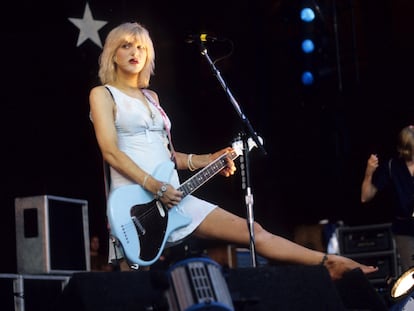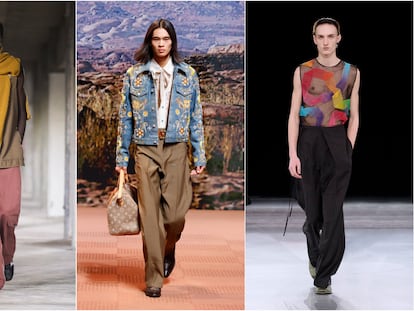A 33-foot Gisele Bündchen: Fashion turns to holograms to capture the public’s attention
Hyper-augmented reality is the new great advertising resource. Calvin Klein opened fire, and Hugo Boss responded via the Brazilian supermodel

Anyone passing by the Tower Bridge on January 31 can be forgiven for ignoring any of the famous monuments in the vicinity, no matter how historically significant they might be. They were dwarfed by Brazilian supermodel Gisele Bündchen. Not because she was visiting London, but because Boss projected a 10-meter-high (33 feet) hologram of her there to present its new spring-summer 2024 campaign. “Every season, we want to do something bold and impactful and disruptive,” Nadia Kokni, senior vice president of global marketing and brand communications at parent company Hugo Boss, told Vogue Business. “Holograms make you do a double take; it’s familiar but a little disconcerting.”
To achieve this hyper-augmented reality, the three-dimensional holograms were created by capturing Bündchen on a set and with a turning platform. The figures are then transmitted using 10-meter transparent LED screens with technology designed so that weather conditions do not affect the image. These screens were placed on platforms in Potter Fields Park near Tower Bridge. Smoke and perfectly choreographed lighting did the rest and the magic was made real.

Although in terms of magic, it’s hard to beat the numbers generated by the latest Calvin Klein campaign. Jeremy Allen White eclipsed the skyscrapers of New York, his image bringing in $12.7 million in media impact in 48 hours, according to Launchmetrics. Allen White was a trending topic on X the day after the campaign was launched and a companion video published on TikTok reached more than 4.5 million views in a week. Calvin Klein didn’t need a hologram of its new brand ambassador to get people talking: the actor himself had to clarify, in the face of constant questions on the subject at the Golden Globes gala, that he had been more excited to receive an award for his role in The Bear than to have starred in the campaign.
But the brand famous for its white briefs is also a benchmark in stealing the limelight from the tallest buildings in the Big Apple with its XXXL campaigns. Back in the 1990s, giant billboards on the most imposing buildings in Manhattan featuring Kate Moss and Mark Wahlberg were the strategy to capture the public’s attention. “You couldn’t help but look at the [Calvin Klein] billboard,” Allen White said in an interview with the American edition of GQ. “It’s so massive. I always associated it — and still associate it — with New York City itself.” He also admitted that he felt intimidated and suffered from imposter syndrome before the photo shoot, as he couldn’t see himself on one of those giant billboards.

This need to impress an audience increasingly accustomed to advertising and the constant stimuli received through cell phones forces brands to find new ways to surprise consumers. The bottom line is that “in this age of TikTok you need to create moments,” as Matt Kissane, CEO of marketing agency Landor, responsible for Calvin Klein’s successful campaign, told Business of Fashion. This is why we are seeing an upsurge in massive billboards and technological resources are becoming more and more spectacular, forcing people to stop, get out of their bubble and look, and then share what they are seeing on their social networks, hopefully making a campaign go viral.
Sign up for our weekly newsletter to get more English-language news coverage from EL PAÍS USA Edition
Tu suscripción se está usando en otro dispositivo
¿Quieres añadir otro usuario a tu suscripción?
Si continúas leyendo en este dispositivo, no se podrá leer en el otro.
FlechaTu suscripción se está usando en otro dispositivo y solo puedes acceder a EL PAÍS desde un dispositivo a la vez.
Si quieres compartir tu cuenta, cambia tu suscripción a la modalidad Premium, así podrás añadir otro usuario. Cada uno accederá con su propia cuenta de email, lo que os permitirá personalizar vuestra experiencia en EL PAÍS.
¿Tienes una suscripción de empresa? Accede aquí para contratar más cuentas.
En el caso de no saber quién está usando tu cuenta, te recomendamos cambiar tu contraseña aquí.
Si decides continuar compartiendo tu cuenta, este mensaje se mostrará en tu dispositivo y en el de la otra persona que está usando tu cuenta de forma indefinida, afectando a tu experiencia de lectura. Puedes consultar aquí los términos y condiciones de la suscripción digital.
More information
Archived In
Últimas noticias
Most viewed
- Sinaloa Cartel war is taking its toll on Los Chapitos
- Oona Chaplin: ‘I told James Cameron that I was living in a treehouse and starting a permaculture project with a friend’
- Reinhard Genzel, Nobel laureate in physics: ‘One-minute videos will never give you the truth’
- Why the price of coffee has skyrocketed: from Brazilian plantations to specialty coffee houses
- Silver prices are going crazy: This is what’s fueling the rally










































